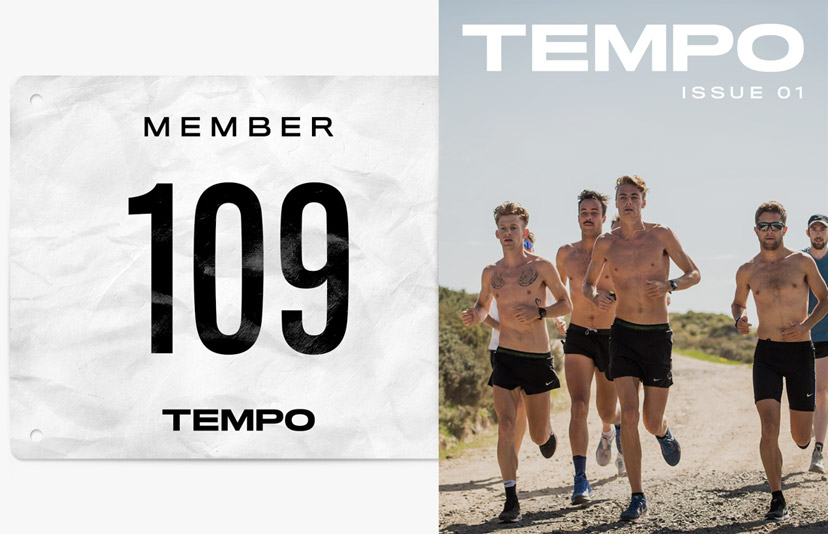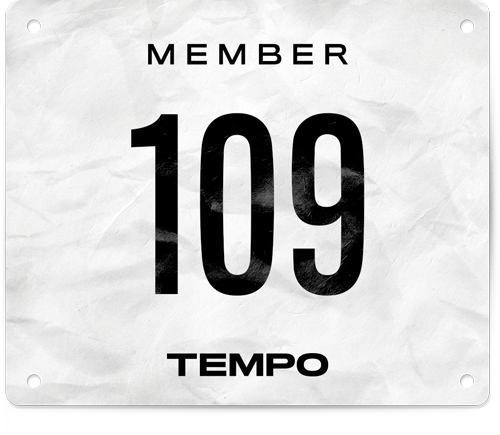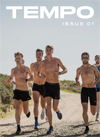Performance
The Tokyo Experiment
Melissa Duncan's going all in for a shot at Tokyo
Lissy Duncan and I are standing outside of the Edogawa Track & Field Stadium in the Nishikasai neighborhood of Tokyo, watching from the wrong side of the fence as some people mull about the home stretch of the track.
“We could hop the fence,” she says as she looks up the 10-foot high expanse.
It’s not so much a suggestion as it is a question--am I willing to hop the fence with her? I’ve been in Tokyo for almost two weeks at this point, and the one thing I know for certain is that the citizens of Japan are not rule breakers. They don’t jaywalk on empty streets. They don’t utter a word on the bus or train, as to avoid causing a “nuisance.” And they certainly do not jump fences.
Lissy senses my hesitation. I can’t be positive, but I feel a hint of disappointment--the 29-year old Australian who's recently uprooted her life and moved it to Japan probably didn’t see the fence as much of a challenge. But I am a weenie, so we make the 200-meter walk to the front gate.
Here is where Lissy flexes a bit and shows what she’s learned during her almost 5-month tenure as a resident of Tokyo and member of the Shiseido corporate running team.
We’re greeted at the front by an employee of the track who seems reluctant to let us in. Lissy responds in Japanese, explaining (or, perhaps, imploring. I can’t understand a word of the exchange) that we just want to take a few pictures and leave. From context, I gather that there’s a youth track meet about to happen. I stand with a group of elementary-aged Japanese school children and their parents, waiting to see if the gatekeeper will let us on the track.
After a brief back and forth, Lissy ushers us onto the track saying she thinks she bought us five minutes. As we walk to the track, I tell her I found the entire thing very impressive, especially since she didn’t speak a lick of Japanese before she arrived in the country. But she manages to downplay it slightly.
“I think maybe the only reason she let us on the track was because she recognized I run for Shiseido,” Lissy says. “I kind of stand out.”
Standing out is something that Lissy has gotten used to since arriving in Tokyo in April of this year. She’s the only non-Japanese athlete on her corporate team, if not one of very few Westerners to ever make the jump to the Japanese Corporate running system, and part of only 2.2% of legal residents of Japan that are non-native Japanese.
But having a bit of a spotlight on her is something Lissy is used to by now. A talented junior athlete, she’s gone on to become a perennial face for Australia on the world stage. Thumbing through her resume may take a minute: World Championships for both indoor and outdoor track, a bronze medal at the World Relay Championships, World Cross Country, as well as the Commonwealth Games and Oceania Championships. Not to mention a handful of meet and national records to boot. Most of this success came within the stretch of 2014-2016, before a devastating injury brought her back down to earth.
“Basically, I broke my foot,” she says.
The injury came in the wake of being selected to represent Australia in the 2016 Rio Olympic Games--a dream achieved. So she did what anyone who has spent a life dedicated to their craft would do: isolated herself and spent the next six weeks cross training and rehabbing in hopes of being on the starting line for the 1500m in Brazil. What she didn’t know at the time was the injury was initially misdiagnosed. So when she re-commenced running on it just a few weeks from the Games, her foot broke again, this time requiring surgery.
“Six screws and a plate,” she says as she holds out her phone showing off an x-ray containing an impressive amount of hardware. “And half a screw is still in there because apparently it broke when they were taking it out.”
Any athlete that’s spent time courting injury can tell you that it’s often accompanied by a mini-existential crisis. Recovery is often a solo-endeavour, and despite Lissy’s overall upbeat demeanor, she questioned whether or not continuing in the sport was the right thing to do.
“Especially coming back from this injury,” she says, “I was kind of like ‘Oh is it just time to get a full time job?’ Ya know I’m getting on a bit and maybe putting a lot of effort into this without it going anywhere…”
She trails off. It was a long and arduous rehab that she described as a “low moment” in her career. Rebuilding her confidence became just as important as rebuilding her body. In a lot of races coming back she described “aiming too low,” a certain complacency she attributed to just being happy to be back running. With as many ups as downs in 2018, Lissy was buoyed by the realization that everyone around her--coaches, parents, sponsors--didn’t necessarily care about her injury. They cared about her and just wanted to see her run well. All things considered, with the magnitude of her foot injury, they didn’t have to wait long.
The first three months of 2019 provided enough fuel for Lissy to fully consider her place in the sport. Though she raced a full 2018 season, she says 2019 was when she was “probably, I think, finally” back. She pinpoints her victory at Australia World Cross Country Trials, or her Australian 5000m title just a month later, or her 26th place finish at World Cross Country Championships a month after that as the bookend to her injury, nearly three years after the fact. But these were the pieces of the puzzle Lissy had been looking for: being not only physically fit enough to run, but mentally willing to be competitive.
So for her, it became time to consider what was next.
“At the start of 2019, I thought about what I wanted to do,” Lissy says. “Yeah, I want to make World Championships, that's good. But I want to make the Olympics. The only thing missing is the Olympics.”
To hear Lissy tell it, you’d think the decision to move to a country where she didn’t even speak the language was more like choosing what she was going to eat for breakfast that morning. Her coach, Melbourne Track Club’s Nic Bideau, had a relationship with a Japanese agent named Wataru Ogushi. Wataru approached Nic looking for someone who might be interested in competing in the Japanese Corporate Ekiden as a member of the Shiseido team. Nic brought it to Lissy.
“I didn’t really think much of it. I was just asked ‘well, do you want to go to Japan and run for a team there?’” she tells me. “And I was just like ‘yeah, sounds good. Why not?’ And I didn’t really think of it much outside of that.”
The opportunity to train in Tokyo with Shiseido presented some obvious challenges: she didn’t speak the language; she’d be living a very long trip from friends and family. But also some not so obvious ones: she’d have to forego what’s become a routine summer of training and racing in Europe due to Corporate Ekiden competition restrictions prohibiting a foreign-recruited athlete from leaving the country for 7-months prior to the race.
There were upsides though: the restriction would allow Lissy to put her head down and spend 2019 concentrating on remaining healthy and scraping together whatever fitness was still left on the table during her time off with injury.
“I didn’t really want to go (to Europe) this year just because of the injury last time the Olympics were around,” she says. “I just want to make it to Tokyo in 2020...I sort of figured if I came to Tokyo there’s actually no pressure to race all year. I can just train and relax. I won’t be grinding day in and day out, racing really hard and potentially putting more stress on my body.”
She continues, “Other than that, I didn’t really have a commitment to being anywhere. My sister has a house, a husband, a dog. She’s there, she’s locked in. I didn’t really have anything that important tying me anywhere.”
That fact changed just a few weeks before Lissy was slated to go to Tokyo when her mom was diagnosed with cancer. With her mom’s prognosis still up in the air and the ink already dried on her Shiseido contract, she considered how important this new endeavor really was. But her mom quickly put that to bed.
“She just said ‘this is such a great experience. You can’t stay behind because of me.’” It’s this type of unwavering support she’s received from her family (aside from her grandmother, who Lissy jokes “keeps asking when I’m going to start having babies.”) that’s allowed her to continue pursuing her career.
“I can’t believe how many runners there are here,” she says to me as we sit along a stretch of riverfront bike path. She’s just returned from a two month stay in Hokkaido, the northernmost island in Japan, where the Shiseido team was headquartered to “escape the heat” during the hellish Tokyo summer. Our interview was actually sandwiched between their Hokkaido training camp and a short stint at elevation--she’s slated to spend less than 24 hours in Tokyo before departing again.
We sit only two train stops from Tokyo Station, but the feel of this part of town is quieter. It’s a touch more relaxed than the scenes of Tokyo you might dream up if you close your eyes: dashes of neon lights, throngs of commuters jammed into a single train car, standing room only at the local cat cafes.
Here, it’s just people on the bike path. Despite the near 35C heat, people jog by in long sleeves and tights as Tokyo Tower looms in the background. I point out what I consider odd style choices to Lissy. She quickly jumps on it. It’s something she’s noticed since her arrival and speculates the layers are either a decision stemming from a more modest culture or strictly for sun protection.
The learning curve extended beyond just an initial long-sleeved culture shock. Despite Lissy’s decade-long tenure in the sport, there was a lot to learn in terms of how Japanese athletics worked.
“The Japanese way is just so different from what I was used to,” she says.
Days for the Shiseido team begin with a 10k run at 6 am, everyday, whether there’s a session scheduled that afternoon or not. Lissy points to a pole along the bike path. When the team is in Tokyo, they start their AM runs at that pole. The run begins with everyone on their watch, coaches on bikes counting down “3-2-1-GO!” Single file running commences and splits are called every kilometer. Breakfast as a team follows, prepared by the chef and dietician on staff. They meet again at 11am, where they’ll either do that day’s workout (accompanied by a pacer, also on the payroll), weights, or cross training. This is followed by PT or massage, provided by another member of the team’s staff. Everyday there’s another run at 4pm, then dinner as a team. Rinse and repeat. Cram in what has become routine travel to different training camps, and you have what Lissy calls a “normal day.”
It’s not uncommon for her other teammates to run anywhere from 200-300km a week, generally at an intensity Lissy raises her eyebrows at, all spread out--if you’re counting--among up to three sessions a day. A less experienced athlete might fall prey to doing too much too soon, but for Lissy, it’s helped reinforce her own training, which is still dictated remotely by Bideau.
“I’ve learned to be confident in my own training. If I have a session at 11am, I’m not up at six doing the first session,” she says. “I know I’m OK running 120km a week. But here there has been more pressure to run faster. And I’m working on not feeling lazy if I need to have an easy day.”
Last week in Hokkaido, Lissy was on a regular training run in a stretch of forest she wasn’t familiar with. It didn’t take long for her to realize she had no idea where she was.
“It got to a point where I was about an hour and forty minutes into the run and I had no idea where I was. I was running around in circles bawling my eyes out. I was just hearing noises all around me. It was cold and rainy and I thought, ‘This is how I die,’” she recalls. “I’m going to get eaten by a bear.”
Eventually, she emerged from the forest. Stumbling onto a main road, she flagged down an oncoming bus and plead her case.
“The only way I knew how to express that I was lost was a word that translated to ‘lost child.’ So they took me on the bus and we drove, like, 15 minutes back to town.”
On a scale of adjusting to life in a new country, near death experiences in the woods are on the more intense side, we’ll give that one a 10. Most of Lissy’s day-to-day struggles come down to a more mild, yet ever present nuisance of the language barrier. None of her teammates are fluent in English, so learning Japanese has been high on her priority list.
A combination of apps and lessons have helped her get a good grasp on the language--even so, meaningful conversation can be difficult to come by. It’s about halfway through our interview, she pauses and says “I feel like I’m not good at explaining myself because I haven’t been talking for so long. I can’t remember any words!”
Lucky for Lissy, running is somewhat of a universal language in Japan. The Japanese corporate team structure is well known all over the world; during the fall and spring, races are regularly broadcast on TV; and it’s home to the Ekiden, long distance relay races, which the Japanese go crazy for. For all intents and purposes, the Ekiden (in particular, the Queen’s Ekiden) is the only reason Lissy is in Japan in the first place.
“Everything I’m doing now, living here, training here, is to just qualify for the Queen’s Ekiden,” she says. “We’re doing the Princess Ekiden in October and it’s the qualifying race for the Queen’s Ekiden. I’m looking forward to that one. It’s supposed to be really big. It’s live on TV. I’ve heard lots of things about it. I don’t think I really even know what to expect.”
She’s managed to get a taste for Japanese competition already. Lissy’s competed in a handful of races, all on the track. It’s where she nabbed her qualifier for Doha after finishing the 5000m in 15:20.88, a near 20-second victory at the Kanakuri Memorial Meet in late April.
“At the meets there’s just kids, heaps of kids, waiting outside of the track for an autograph,” she says.* “If you say anything in Japanese to them they’ll just squeal. The people are definitely more enthusiastic about it here.”*
Lissy and I catch up over the phone a few weeks after our initial sit down in Tokyo. She’s still at altitude, and parts of the east coast of Japan are under a typhoon warning. The World Championships start in just a few weeks and Lissy is mentally preparing for the competition. This will mark her second time representing Australia at the World Championships, but more importantly for her, it'll be the first time she will see her family since leaving for Tokyo.
Lissy’s mom received her last round of chemotherapy a few weeks prior to our call and was given the all clear to travel to Doha. Meanwhile, despite being weeks away from their travel date, her dad sent her a picture of his packed suitcase. “For Doha it’s gotta be just a few singlets and a pair of shorts. But still,” she says. “He’s really excited.”
Earlier in our conversations Lissy described her athletics career as an exercise in ticking off boxes, goals on a list of things any athlete would be proud to accomplish. If her early career was purely a hunt for accolades, this chapter, the Shiseido chapter, has become more about growth and considering the means just as much as the ends.
“I still want to go out and compete, of course. But the main thing that I want to achieve from my running is to just have good experiences and to make my running affect me as a person,” she says. “I don’t want to be defined by my results. I don’t want my worth to be my place at world majors. I want to take something from everything I did as a runner. The good and the bad.”


